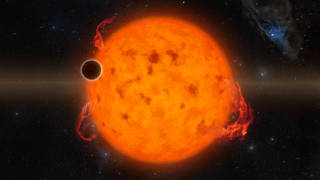
K2-33b, shown in this illustration, is one of the youngest exoplanets detected to date. It makes a complete orbit around its star in about five days. Photo: NASA/JPL-Caltech.
WASHINGTON (BNS): Astronomers have discovered the youngest fully formed exoplanet ever detected. The discovery was made using NASA's Kepler Space Telescope and its extended K2 mission, as well as the W. M. Keck Observatory on Mauna Kea, Hawaii.
The newfound planet, K2-33b, is a bit larger than Neptune and whips tightly around its star every five days. It is only 5 to 10 million years old, making it one of a very few newborn planets found to date.
"By comparison, the planet K2-33b is very young. You might think of it as an infant," said Trevor David of Caltech in Pasadena, lead author of a new study published online June 20, 2016, in the journal Nature.
"The newborn planet will help us better understand how planets form, which is important for understanding the processes that led to the formation of Earth," said co-author Erik Petigura of Caltech.
Astronomers have discovered and confirmed roughly 3,000 exoplanets so far; however, nearly all of them are hosted by middle-aged stars, with ages of a billion years or more.
A surprising feature in the discovery of K2-33b is how close the newborn planet lies to its star. The planet is nearly 10 times closer to its star than Mercury is to our sun, making it hot.
The first signals of the planet's existence were measured by K2. The telescope's camera detected a periodic dimming of the light emitted by the planet's host star, a sign that an orbiting planet could be regularly passing in front of the star and blocking the light. Data from the Keck Observatory validated that the dimming was indeed caused by a planet, and also helped confirm its youthful age.
Ames manages the Kepler and K2 missions for NASA's Science Mission Directorate. NASA's Jet Propulsion Laboratory in Pasadena, California, managed Kepler mission development. Ball Aerospace & Technologies Corporation operates the flight system with support from the Laboratory for Atmospheric and Space Physics at the University of Colorado at Boulder.
 Previous Article
Previous Article Next Article
Next Article













The Indian Air Force, in its flight trials evaluation report submitted before the Defence Ministry l..
view articleAn insight into the Medium Multi-Role Combat Aircraft competition...
view articleSky enthusiasts can now spot the International Space Station (ISS) commanded by Indian-American astr..
view article